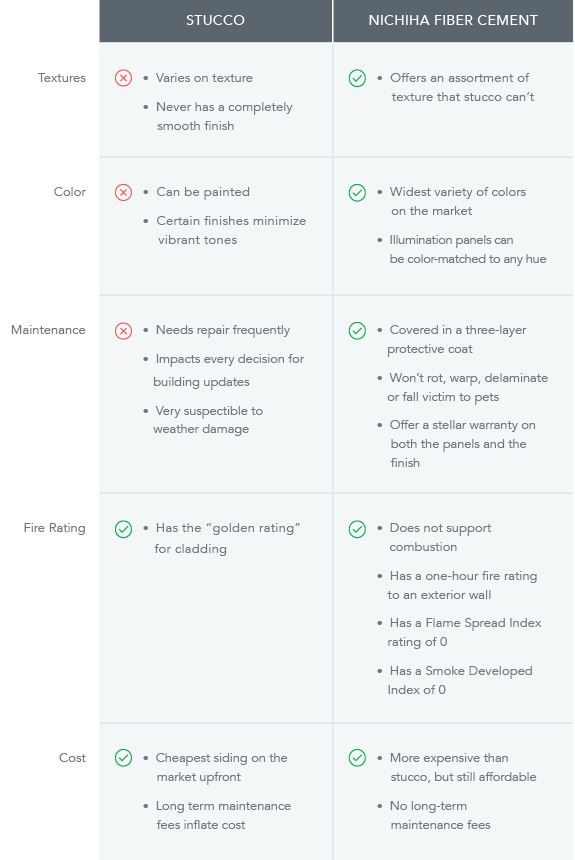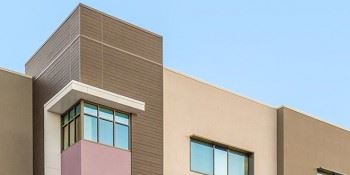The Southwest is a region often shown through stock images. Sometimes it is a brilliant sunset reflecting off of red rock formations in a desert landscape peppered with cacti. Other times, it is the blinking lights bouncing off sequined dresses in Las Vegas. And, of course, there are always the palm trees and sunglasses-wearing celebrities of LA strolling down Rodeo Drive.
As varied and complex as these pictures seem, the architecture in this area can be summed up into a single word'stucco. Building design in the Southwest states has long been dominated by this singular siding, plastered on nearly every building in the region. In fact, stucco covered 30 percent of buildings erected in 2016.
For an architect based in the Southwest, this norm is both a blessing and a curse. Drafting another stucco-covered building ensures that a project meshes with the current landscape, but it also sets up a structure to blend into its surroundings, lost among the many. And treading too far outside of the boundaries can make a building a sore thumb rather than a sight to see in a sea of stucco. These design issues can hinder an architect's design aesthetic, especially given stucco's widespread use. A 'signature style,' which can't be duplicated by another firm, is difficult to attain.
This conundrum must be why designers in this region are feeling stuck, plagued by a creative itch that they are unsure how to scratch. Architects desperately want to break up the scenery and create a space that will inspire and excite clients and passersby alike.
This design riddle actually has a simple answer'add to the current look instead of completely replacing it. Stucco is an excellent siding to serve as a base for fresh, modern accents that bring a structure to life while still respecting the long-standing vibe of the region.
Though it might seem that the world of design possibilities has just opened up, the reality is that not all materials are right for the area or to be paired with stucco. Traditional wood won't stand up to the rigorous fire codes and will bleach in the sun, traditional brick compromises the Southwestern aesthetic, and the color palette of stacked stone can easily clash with the natural rust red of the region.
But, we've done the research and have a few ideas to help choose the right cladding. This easy guide will ensure that a building complements rather than clashes with the unique tones, texture and makeup of stucco.

Design Tip 1: Choose textures that complement.
From coarse to flat, stucco does offer a somewhat limited range of finishes. No matter the consistency, however, stucco always packs a depth that personalizes a structure. This intensity means that it can be a challenge to choose a texture to pair with it ' or, in the right hands, it is an opportunity.
First, decide whether the building would benefit from emphasizing the consistency of the stucco or blending with it. If harmonizing works best, a flat cladding would easily pair with a smooth or Santa Barbara finish and a rougher siding might suit better with a lace or float texture.
A bolder move is to highlight the natural feel of stucco, perhaps by putting a cat face or dash texture with a siding that speaks to the rustic approach. The feel of stucco is also beautiful when side-by-side with a wood panel, as the natural tones integrate flawlessly.

Design Tip 2: Choose tones that balance.
While traditionally kept in a neutral or earth tone, stucco can be painted any color. That's why it is essential to choose siding that meshes exactly with the color scheme. After all, a tonal imbalance on a building is often the first thing that people notice.
To ensure that this doesn't happen, try a siding that can be matched precisely. Check with your provider to ensure that they offer color matching, no matter if it is a classic neutral or a modern neon.
Contrasting tones are also a current trend. An easy way to honor the region with a modern twist is to use the natural desert coloring as inspiration. Pair these warm hues with cool wood touches to spark a color marriage that glows.

Design Tip 3: Choose low-maintenance supplemental materials.
While stucco's neutral tones make it seem like the ideal Southwestern canvas, there are several considerations that come along with it. These same benefits can limit it to a specific aesthetic. This is why it is crucial to pick a cladding that uplifts the siding rather than dragging it down.
Stucco requires significant maintenance. Since it will more than likely require regular repainting and repair, choose a siding to pair with it that will not need such touchups over time. The additional cladding should also experience minimal damage from natural wear and tear. Also, ensure that the complementary siding won't bleach over the many sunny days the region is known for or be torn away by harsh winds that can occasionally rip the Southwest states.

Get Up Close And Personal
Want to see a color up close or feel the texture in person? Order as many complimentary finishes as you need to find the perfect option for your project.
A great example of a product that fits all three of these criteria is Nichiha Fiber Cement Architectural Wall Panels. When balanced with stucco, it can elevate this common Southwest building material by adding color and texture, allowing the simple beauty of stucco to shine.

Breaking out of a creative rut is never easy, but completely ignoring the regional needs and aesthetic can cause just as many problems. Remember that small changes make a big impact when done correctly'like pairing Nichiha Fiber Cement panels with stucco.
![]() To learn more about creating the perfect blend of stucco and fiber cement, request a sample at Nichiha.com/DesignforStucco or set up a consultation at Nichiha.com today.
To learn more about creating the perfect blend of stucco and fiber cement, request a sample at Nichiha.com/DesignforStucco or set up a consultation at Nichiha.com today.


